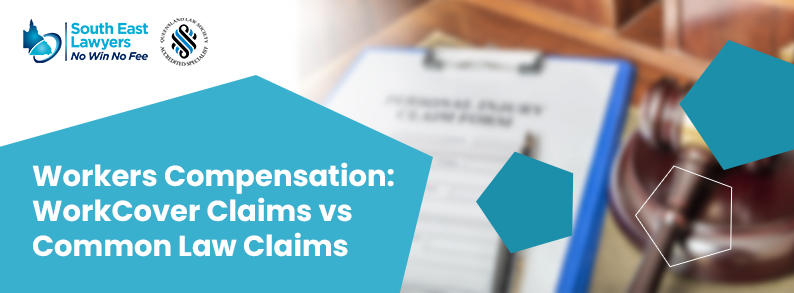In Queensland, navigating the path to recovery after a work-related injury involves understanding the protections and compensations available under the law.
Central to this journey is comprehending the differences between a WorkCover claim and a common law claim. These two avenues offer distinct options for workers seeking recompense for injuries sustained in the workplace.
In this article, we’ll discuss these options, and provide guidance on what each type of claim entails, the benefits and limitations of both, and crucial considerations for Queensland workers embarking on this legal pathway.
What is a WorkCover Claim?
In Queensland, the first step towards securing compensation for a workplace injury is through a WorkCover claim.
This process is designed to be straightforward, enabling workers to receive prompt support for their recovery.
WorkCover Queensland, the primary body overseeing workers’ compensation, ensures that injured employees are not left to navigate their healing journey alone.
To initiate a WorkCover claim, an injured worker must report their injury to their employer and seek medical attention. The documentation from these steps forms the basis of the claim, which is then submitted to WorkCover Queensland for assessment.
Through a WorkCover claim, employees can access a range of benefits. These include coverage for medical and rehabilitation expenses, compensation for lost wages during the period of incapacity, and support for returning to work. The aim is to alleviate the financial burden of the injury, ensuring the worker can focus on recovery.
While a WorkCover claim operates on a no-fault basis, it may be the precursor to exploring more comprehensive legal avenues. For workers whose injuries have long-term implications or where employer negligence is a factor, a common law claim offers a pathway to seek further compensation. This option requires a deeper legal engagement, where the nuances of the injury and its impact on the worker’s life and employment are closely examined – let’s look at this in more detail.
What is a Common Law Claim?
A common law claim represents a pivotal moment in a worker’s journey towards justice and fair compensation in Queensland. Unlike the initial WorkCover claim, which is processed on a no-fault basis, a common law claim delves into questions of liability and negligence. It’s a path taken when the injury’s severity and circumstances suggest that more substantial compensation is warranted, reflecting the true extent of the impact on the worker’s life.
To pursue a common law claim, an injured worker must first have their case assessed by WorkCover Queensland. This involves receiving a Notice of Assessment which includes a lump sum offer based on the injury. However, accepting this offer without legal advice can preclude the option to seek further damages through a common law claim. Thus, we always recommend that you seek legal advice before going down this path.
The essence of a common law claim lies in proving that the employer’s negligence contributed to the injury. This requires gathering evidence, expert testimonies, and often, a negotiation process that may lead to a settlement before reaching court. If a settlement cannot be reached, the case may proceed to trial, where a judge will decide.
The scope of compensation in a common law claim tends to be broader than that of a standard WorkCover claim. It can encompass past and future lost earnings, medical and rehabilitation costs not covered by WorkCover, pain and suffering, and loss of life enjoyment. This comprehensive approach to compensation aims to cover the full spectrum of the worker’s losses.
Pursuing a common law claim is a decision that should not be taken lightly. It involves navigating complex legal terrain, potential court appearances, and a longer resolution time. However, for many, it represents the best avenue to secure compensation that fully acknowledges the gravity of their injuries and the negligence that caused them.
Differences Between WorkCover and Common Law Claims
Understanding the nuances between a WorkCover claim and a common law claim is crucial for any Queensland worker navigating the aftermath of a workplace injury. These two pathways offer different benefits and cater to varied circumstances surrounding an injury, highlighting the importance of making informed decisions based on one’s specific situation. We’ve summarised these difference below:
Basis of Claim:
- WorkCover Claims: These are processed on a no-fault basis, meaning that compensation is available regardless of who was at fault for the injury. The primary goal is to support the injured worker’s recovery and return to work.
- Common Law Claims: In contrast, common law claims require the injured worker to prove that their employer was negligent, leading to the injury. This pathway allows for the pursuit of a broader range of damages.
Compensation:
- WorkCover Claims: Compensation typically covers medical expenses, rehabilitation costs, and a portion of lost wages. There are limits on the amounts and duration of these benefits.
- Common Law Claims: These claims can result in significantly higher compensation, covering not only medical expenses and lost wages but also pain and suffering, future economic loss, and other non-economic damages.
Process and Timeframes:
- WorkCover Claims: The process is designed to be relatively quick and straightforward, facilitating the worker’s recovery and return to employment.
- Common Law Claims: Pursuing a common law claim is more complex and time-consuming, often requiring legal representation and potentially going to court.
Impact on Future Employment Relations:
- WorkCover Claims: Generally, these claims are less likely to strain the employer-employee relationship, as they do not involve proving fault.
- Common Law Claims: Since these claims involve allegations of negligence, they might have implications for the worker’s ongoing relationship with their employer or future employment prospects.
Considerations Before Pursuing a Common Law Claim
Deciding to pursue a common law claim in Queensland is a significant step that requires careful consideration. This decision not only involves understanding the potential for greater compensation but also weighing the emotional, financial, and professional implications of such a legal action.
- Legal Representation and Costs: Engaging in a common law claim often necessitates hiring a legal professional who specialises in workers’ compensation law. It’s vital to discuss legal fees, potential costs, and payment structures (such as no-win, no-fee agreements) upfront. Understanding these financial commitments is crucial for making an informed decision.
- Evidence and Proof of Negligence: Success in a common law claim hinges on the ability to prove employer negligence. This involves gathering comprehensive evidence, including witness statements, medical records, and expert testimony. The burden of proof can be substantial, requiring detailed preparation and legal expertise.
- Emotional Toll and Time Investment: The process of pursuing a common law claim can be lengthy and emotionally taxing. It involves revisiting the details of the injury and its impact on your life, which can be a challenging experience. Prospective claimants should be prepared for the emotional journey ahead, alongside the legal battle.
- Potential Impact on Employment Relationships: As we mentioned above, initiating a common law claim against an employer can alter professional relationships. While it’s a legal right to seek compensation for negligence, it’s important to consider the long-term effects on your career, reputation, and potential employment opportunities.
- Long-Term Benefits vs. Immediate Needs: While common law claims can offer substantial compensation, including for future losses and suffering, they also take longer to resolve than WorkCover claims. Injured workers need to balance their immediate financial needs and recovery with the potential long-term benefits of a successful common law claim.
- Seeking Expert Advice: Given these considerations, consulting with a legal professional experienced in workers’ compensation claims becomes indispensable. Legal advice can help navigate the complexities of the law, evaluate the strength of your case, and make a strategic plan tailored to your unique circumstances.
Thinking About Making a Claim for Your Work Injury?
Navigating a workers’ compensation claim in Queensland can be a daunting task. Whether you’re considering a WorkCover claim or exploring the possibility of a common law claim, the guidance of experienced legal professionals is invaluable.
South East Injury Lawyers specialise in helping injured workers understand their rights and secure the compensation they deserve. Our expertise in the Queensland workers’ compensation system ensures you have the support and representation needed to navigate your claim successfully.
If you’re facing the complexities of a workers’ compensation claim, don’t go it alone. Contact South East Injury Lawyers today to ensure your rights are protected and to take a significant step towards your recovery and financial security.






